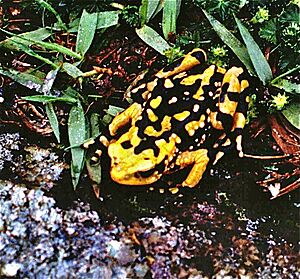Atelopus petersi facts for kids
Quick facts for kids Atelopus petersi |
|
|---|---|
 |
|
| Conservation status | |
| Scientific classification |
The Atelopus petersi is a special kind of toad that belongs to the Bufonidae family. It is also known as Peters' stubfoot toad or Peters' jambato toad. This toad lives only in Ecuador. You can find it in the Cordillera Oriental mountains, mainly in the Napo Province.
This toad was named after James A. Peters. He was an American zoologist who first found these toads in 1962.
What Does Peters' Stubfoot Toad Look Like?
These toads are not very big. Adult males are about 35–42 mm (1.4–1.7 in) long. Adult females are a bit larger, measuring about 43–50 mm (1.7–2.0 in) from snout to vent.
They have a pointy snout. You won't see any ear parts on them. Their fingers have small fringes on the sides, but they are not webbed. Their toes, however, are webbed.
The back of the toad often has bright yellow or orange patterns. These patterns are on a black background. Sometimes, the toad might look almost completely black. They have small bumps and warts on their skin, which can have white tops. The sides of their body are white. Their belly is usually white, but it might have black marks. Some toads have a uniform orange or reddish-orange belly.
Where Do Peters' Stubfoot Toads Live?
Atelopus petersi lives in mountain cloud forests. They also live in high evergreen forests. These forests are found at elevations of 2,660–3,300 m (8,730–10,830 ft) above sea level.
Scientists have found these toads in different places. They have been seen hiding under rocks near streams. Some were found in streambeds during the day. Others were under logs on grassy hillsides. They have also been spotted on cushion plants in paramo (a type of grassland). You might even see them on a trail or along the edge of a river.
Why Are These Toads in Danger?
Long ago, Atelopus petersi was very common. Especially near a place called Papallacta. However, their numbers have dropped a lot. The last time a scientist officially saw one was in 1996. That was a dead toad.
Some local people in Oyacachi said they saw a few toads in 2003. But it is very rare now. Scientists are worried that this species might be extinct. This means they might have completely disappeared from Earth.
The exact reasons for their decline are not fully known. But scientists think two main things might be causing it. One is changes in the climate. The other is a serious frog disease. This disease is called chytridiomycosis. It is a fungal infection that affects amphibians worldwide.


